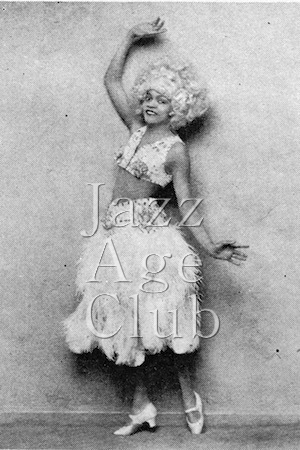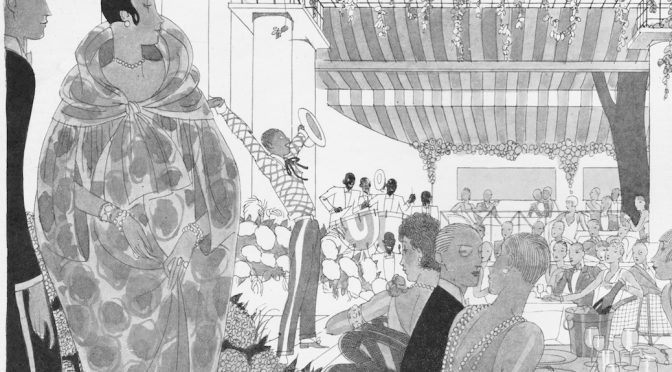The Ambassadeur Show 1926
Edmund Sayag’s first show at the newly renovated Café des Amabassadeurs was Lew Leslie’s all-black production Blackbirds of 1926. Direct from New York, Blackbirds capitalised on the success of The Revue Negre, featuring Josephine Baker, staged earlier in 1925 and was an instant hit.

The inauguration of the new Café des Ambassaseurs with the Blackbirds show was at a private midnight VIP party on 27th May 1926 and was the most fashionable function of the season. The restaurant was packed with an audience of smart Paris society along with American and French stage celebrities. Taking advantage of the champagne, fois-gras sandwiches and petits fours were amongst many others Josephine Baker, Dora Duby, Marion Forde, Sacha Guitry, Yvonne Printemps, Maurice Chevalier, Yvonne Valle, Jane Marnac, the Rowe Sisters, Argentina, Nikitina, Irene Wells, Antonia Adison and the Dolly Sisters.
The show, imported through Lew Leslie, who had made it such a success in New York at the Plantation club, starred Florence Mills and her troupe including the sensational dancer Johnny Hudgins, the Three Eddies and the Plantation Jazz Orchestra conducted by Shrimp Jones with Johnny Dunn, the crack trumpeter and ran for two and a half hours. From the outset all Paris was talking about the show, the performers and the music and it was being called ‘the fastest show in Paris.’

The legendary Florence Mills made her first appearance by emerging out of a birthday cake carried onstage and sang her first song ‘Silver Rose’. She was regarded as a bewitching little figure, her dancing always graceful and her singing voice clear and high. She went on to sing ‘I’m a Little Blackbird’, ‘I Want Nobody But You’, ‘Dinah’ and toward the end she sang ‘Blackbird.’ The song ‘You Won’t Go to Heaven When You Die by the chorus was also greatly lauded. The Three Eddies were adored for their eccentric dancing, Jones and Jones were highly amusing in their ‘Weerie Willie’ sketch and Johnny Hudgins, the silent pantomime clown, entranced everyone with his whimsical steps.
The staging and costumes were highly admired especially in the Jungle Land, Jazz Came From the South, and the Pirate Den scenes. Dancing was also a big features with an exhibition of the Charleston by several dusky maids in seven different ways, a display of clog dancing and the negro parade of wooden soldiers with the effect of the drums given by the beating of the feet. The initial costumes were all created in New York by the Brooks Costume Company. However, according to an interview in the Daily Mirror in early August 1926, the English designer based in London, Dolly Tree said she had completed 150 sketches ‘for the new cabaret show at the Ambassadeurs in Paris.’ Perhaps these sketches were for the revised edition staged in August.
One of Edmund Sayag’s innovative tactics was to continually change the programme to maintain interest and encourage repeat visits. Thus, in Early July, Paul Whiteman and his orchestra arrived with a supporting troupe that included Harland Dixon. They were to replace the Blackbirds show, but Blackbirds was far too popular. So, Sayag alternated their performances between the Ambassadeurs and the Champs Elysees Music hall for two weeks. On 16th July Sayag replaced Whiteman’s band with Irving Aronson’s Commanders, added the magnificent ballroom dancing team of Moss and Fontana at the Ambassadeurs and from the end of July included a ballet performance of La Vengeance Des Dieux at the Champs Elyees Music Hall. Later, in August, Florence Mills and her troupe, Paul Whiteman and Irving Aronson’s Commanders all played the Kursaal, Ostend. The troupe returned to the Ambassadeurs at the end of August for a final week with a revised show that was a try-out for the debut of the show in London at C.B. Cochran’s Pavilion Theatre in early September.
Shortly after the opening of Blackbirds at the Ambassadeurs in early June, there was a rather extraordinary altercation with American protests at a negro dancing with a white woman. A group of Americans objected to a coloured charleston dancer professionally called Frisco, dancing with a white woman and a general row was the result. The disturbance started during the imtermission of the Blackbirds show when Frisco, a supposed American but actually a British subject, made his way to the dance floor and danced with the white woman. The management requested he refrained from dancing. His refusal was countered by an order to the tango orchestra to cease playing. When this happened the Negro Jazz band with the show started to play and Frisco resumed upon the suggestion of the white woman’s husband. The Americans again protested causing a further disturbance. The husband complained to the police about the matter saying that Frisco was his guest and dancing with his wife at his personal request. The nationality of the husband and the wife was not determined but it was presumed they were French. Variety finished their report with ‘on the continent the coloured race is not discriminated against as a rule.’
All images and text © copyright Gary Chapman / Jazz Age Club and must not be re-used without prior consent





One thought on “The Ambassadeur Show 1926”